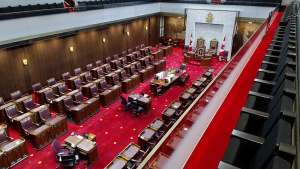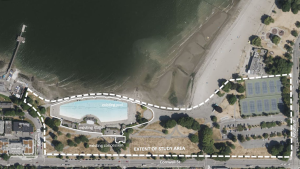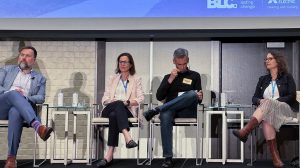Employers in Ontario’s construction industry, are subject to the WSIB CAD-7 Experience Rating Plan, which unlike the NEER plan applicable to other employers, uses both accident cost and frequency for the determination of refunds or surcharges.
Focus on Safety, Security & Fire Protection
BY MARK SENICAR
(DCN SPECIAL)
You can split the atom, but not the frequency count.
Employers in Ontario’s construction industry, are subject to the WSIB CAD-7 Experience Rating Plan, which unlike the NEER plan applicable to other employers, uses both accident cost and frequency for the determination of refunds or surcharges.
Under the CAD-7 plan, each lost-time injury is counted once per year but each year is reviewed over two CAD-7 statements. (Depending on an employer’s premiums, the cost of a lost-time accident can range from, approximately $1,000 to $15,000.)
Accordingly, employers will go to great lengths to avoid that one dollar of nonhealth- care costs, which produces an accident frequency count of “one” under the plan.
The skewing effect of the frequency component in the CAD-7 formula attracted comment in tribunal decision 894/89 as follows: “The employer in this case illustrates that phenomenon in that his accident frequency rate is approximately three times better than the norm, nonetheless, by virtue of the formula, the negative divergence from the norm far outweighs the impact of positive divergence from the norm”.
After observing the relatively greater impact of the frequency count under the formula, as opposed to costs, the Tribunal Panel in decision 894/89 went on to state: “At a certain point under this formula the financial consequences of reporting a claim are sufficiently Draconian that it becomes more cost effective to offer workers alternative compensation benefits, i.e. paid leave, or to encourage workers to remain at work without necessarily performing any task”.
Quite apart from the engagement in such practices at all in order to avoid a frequency count altogether, the issue of how the frequency count is treated under the CAD-7 plan has arisen in Three somewhat different contexts before the Workplace Safety and Insurance Appeals Tribunal.
Two of the cases involved whether or not an employer should in fact receive a full 1.0 frequency count in respect to the claim. Firstly, where there was Second Injury and Enhancement Fund relief applied, and secondly, where there was a transfer of 50 per cent of the cost of the claim due to negligence on the part of another Schedule –1 employer. The third case involves the situation where, although there was no lost time, the worker eventually received a small NEL award.
In decisions 1132/981 (September 21, 1998) an employer endeavoured to have the 50 per cent SIEF relief granted in the worker’s claim also factored in to the lost-time injury count (the frequency component) in its CAD-7 assessments. The employer had submitted to the board that: “We contend that the CAD-7 lost-time frequency be adjusted to the level of responsibility reflected by the SIEF award when it can be shown that the preexisting condition influences or contributes to cause. For example, where cost relief is granted as 50 per cent and a casual link can be determined, we submit that the employer under CAD-7 be charged with 0.5 frequency.”
The board denied such a request stating that: “The lost-time injury count is only used in the CAD-7 formula. It would be a double benefit to construction employers if the lost-time injury frequency and the claim cost were adjusted to reflect the level of SIEF relief.”
The employer had also contended that inasmuch as Board Policy 08-05-08 allows for a frequency adjustment under the CAD-7 plan when, in the case of an automobile accident, negligence could be proven and there was a transfer of cost, that the board did in fact possess the authority to reduce the CAD-7 employers frequency rate when claims were (also) awarded cost relief.
The board, defending its practice of not factoring SIEF relief into the frequency components stated: “If the WCB were to apply the SIEF cost relief into the frequency element, the components for the forcasted average rate frequency would also have to be actuarially amended to account for thousands of SIEF claims processed in any given year.
The matter thereafter came before the Appeals Tribunal, which concluded that it did have jurisdiction to hear the appeal as it involved, “The calculation of premiums payable by this employer.” However, before going on to rule in the case, the Tribunal noted a prior decision which stated: “In merit rating system appeals, Tribunal Panels will likely weigh the importance of systemic fairness (ensuring that a particular employer is treated the same way under the plan as all other employers with the same experience) against the argument any individual employer might make for the modification of the parts of the plan in his/her case.” Also noted was the fact that the Tribunal would ordinarily accord the board considerable deference with respect to assessment policies and merit rating systems.
Prior to deciding the issue of whether or not SIEF relief could and should affect the frequency component, under CAD-7, the tribunal vice-chair requested that the board firstly provide policy document which contained an express reference that SIEF relief would only be applied to the cost element of the CAD-7 formula, as to what circumstances might be considered “sufficiently exceptional circumstances to warrant an exception to this policy,” and finally how the frequency component was treated in a non-SIEF Transfer of Cost situation.
The board subsequently provided such clarification. Injury count exclusion under CAD-7 could occur in the following situation: long latency industrial disease claims, third party claims; third party motor-vehicle accidents; and adjustments for workers who received benefits for attending medical appointments.
As to the SIEF and Transfer of Cost scenarios, the board advised that: “In calculating refunds and surcharges for CAD-7, the frequency component will only be adjusted if either SIEF relief is 100 per cent or if the Transfer of Cost as of result third party negligence is 100 per cent. If either SIEF relief or Transfer of Cost as a result of third party negligence is 100 per cent. If either SIEF relief or Transfer of Cost is less than 100 per cent, only the cost component of CAD-7 is adjusted.”
While agreeing with the employer’s representative that there did not appear to be any “policy” which specifically empowered the board to factor SIEF relief into only the cost component of an employer’s CAD- 7 formula and not into the frequency component, there was however a well established board practice over 16 years of so doing, and further, the board had set out its administrative and policy reasons for having taken this approach since the implementation of the CAD-7 plan in 1984.
Finally, in denying the employer’s appeal, the tribunal vice-chair reached the conclusion that there was nothing exceptional in the employer’s case to justify granting the remedy if requested and that what the employer was really requesting was not an exemption from the board’s practice based on the merits and justice of the case, but an amendment of that practice.
To grant the employer relief as requested would in fact be looking behind the particular claim file and inquiring into the creation of, or the administration of, the appropriateness of the CAD-7 system.
The next challenge to the 1.0 injury count practice arose in tribunal decision no. 1975/01. In that case, the injury to the employer’s worker was regarded by the board as being contributed to by another schedule-1 employer, with the consequence that 50 per cent of the cost of the worker’s claim would be transferred to the other employer.
While the transfer of the 50 per cent of the costs of the worker’s claim was duly reflected in the employer’s cost statements there was, however, no adjustment to the firm’s accident frequency rate.
The employer requested that the board remove 0.5 of an accident from the employer’s accident frequency to reflect the section 10 of subsection (9) cost transfer. The Board denied the request stating that according to the rules governing the operation of CAD-7 Experience Rating Plan, “an accident resulting in claim costs of more than $1 in a year will produce an accident frequency count of one.”
In addition, if each of the two CAD-7 employers involved were assigned a 0.5 frequency to reflect the division of claim costs in half, the end figure would still be a 1.0 frequency count in respect to the claim.










Recent Comments
comments for this post are closed